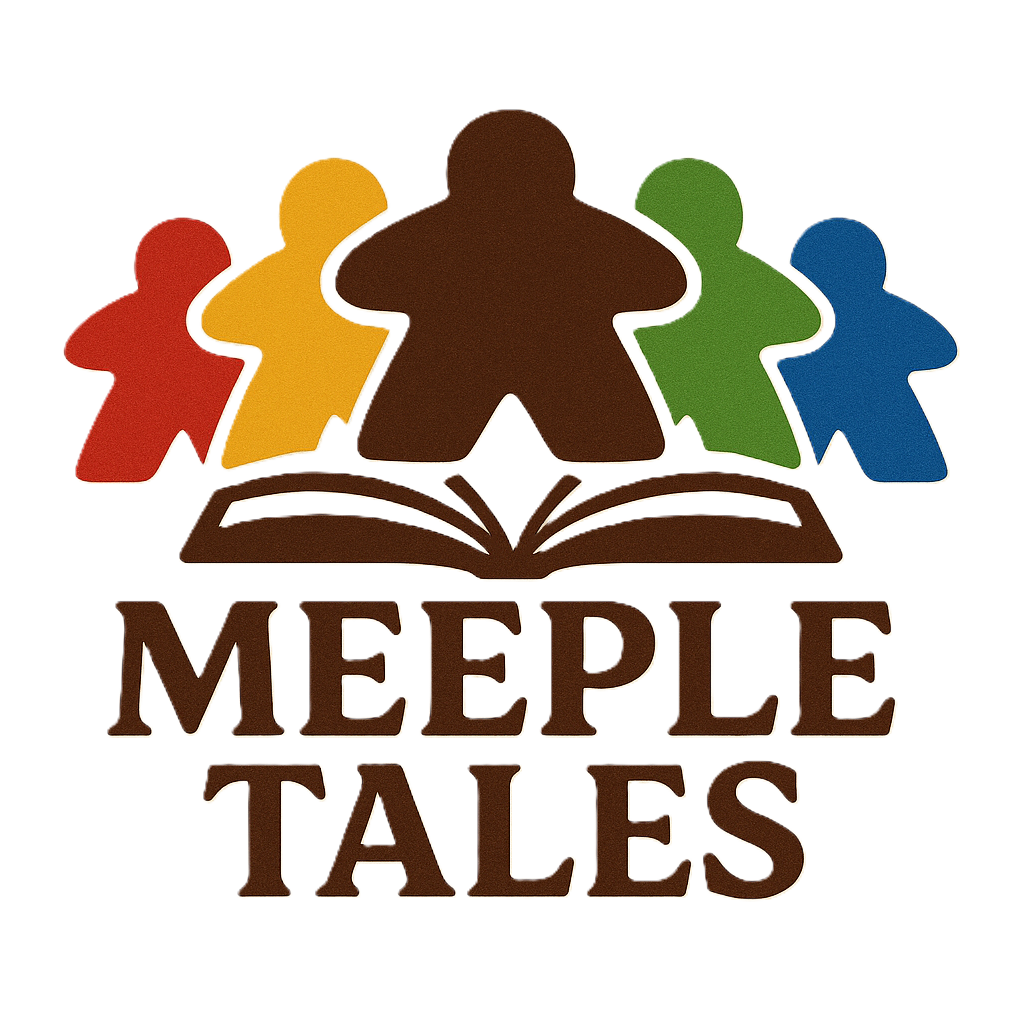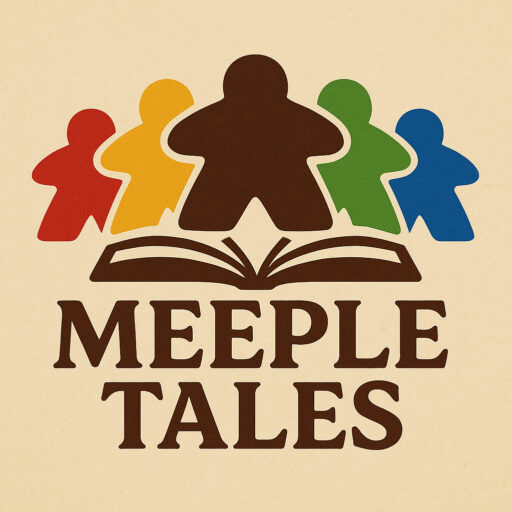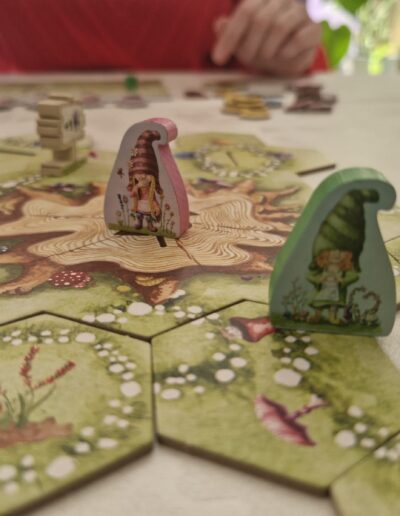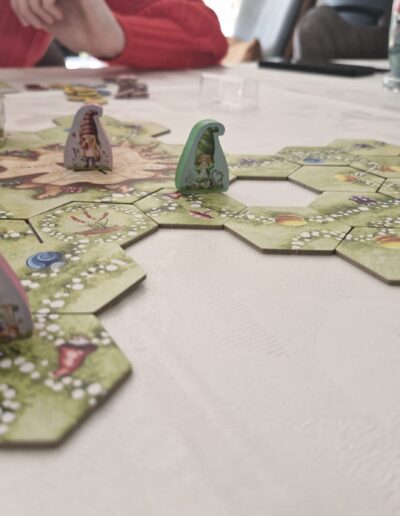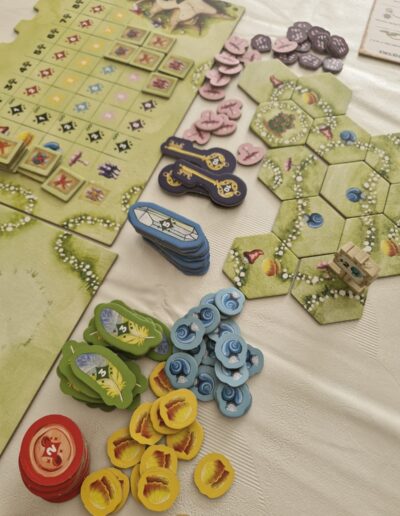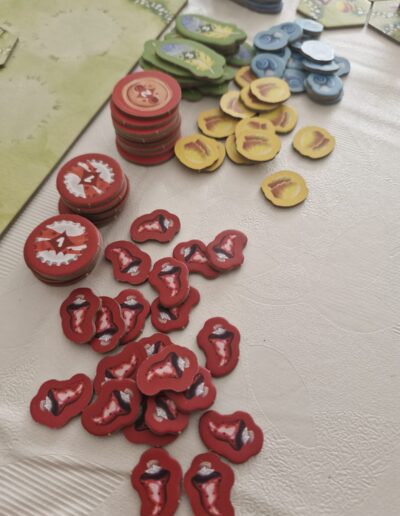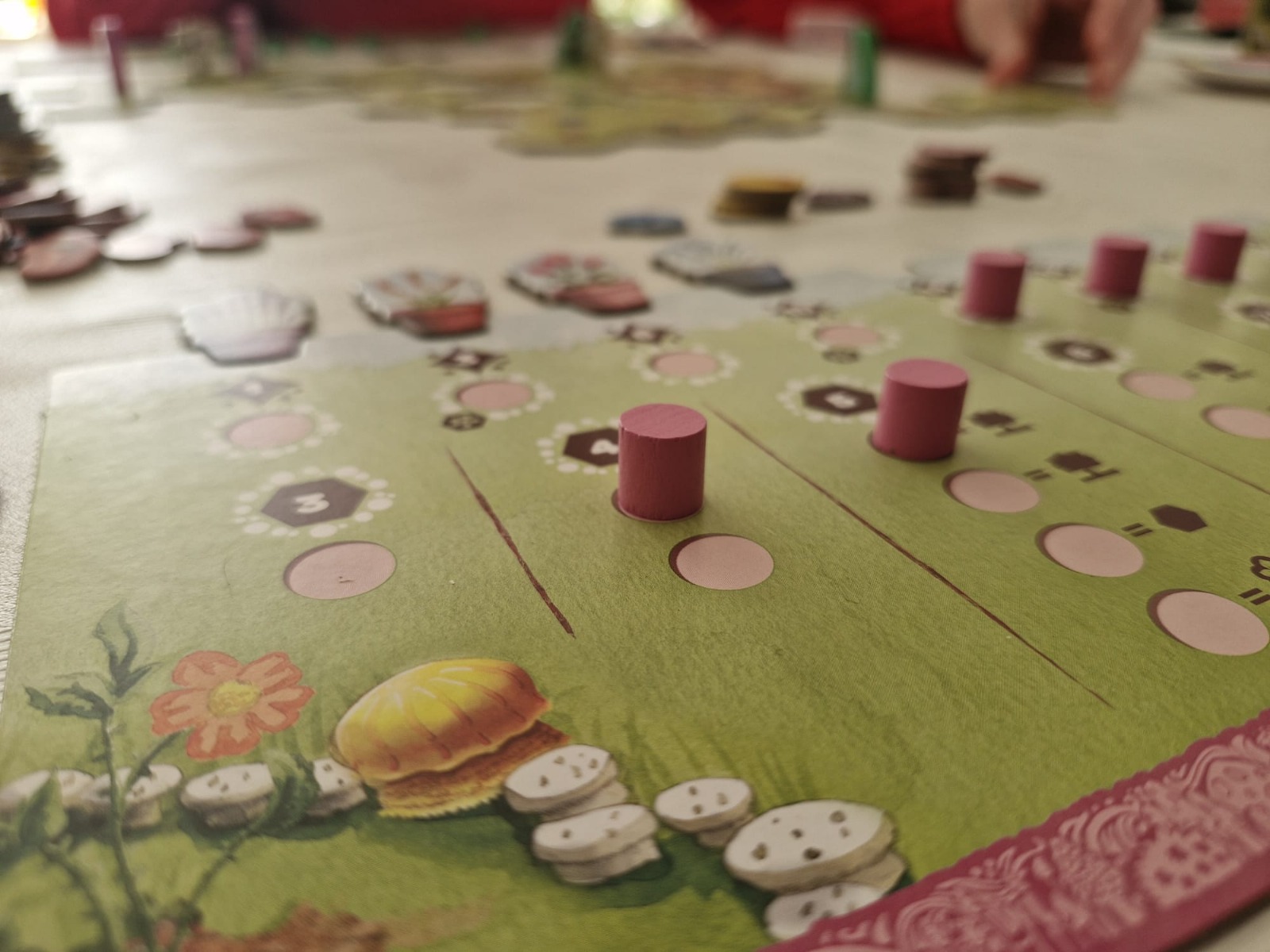Aantal spelers: 2-4
Speelduur: 45-60 minuten
Leeftijd: Vanaf 10 jaar
Auteur: Ammon Anderson
Uitgever: White Goblin Games
Jaar: 2024


Dit is een herpublicatie van een review die ik eerder schreef voor bordspelwereld.nl
Wie kent er nog de verhalen van David de Kabouter, die met zijn vrouw Lisa en vos Swift allerlei avonturen beleefde in het bos? De tekenfilmserie die gebaseerd is op het boek “Het werk van de Kabouters” van Rien Poortvliet. Als kind heb ik zowel de boeken als de tekenfilms verslonden. Om eerlijk te zijn: als volwassene ook. Daar waar koffietafelboeken helemaal hip zijn en je als goed burger tegenwoordig ergens in je Feng Shui-ingerichte Marie Kondo-huis een plaatjesboek van een of andere design-grootheid hoort te hebben liggen, prijkt bij mij gewoon nog good old Rien op de tafel. Jan des Bouvrie zou zich omdraaien in zijn graf.
Maar goed, die was in mijn stereotyperende brein/ fantasie toch al niet zo’n frivool kabouter- of spelletjes-mens. Maar dat ligt dus aan mij. Al zou ik precies daarom met hem wel eens een potje Gnome Hollow willen spelen. Want wat een verrijking is dit spel voor het kind in jezelf. Gewoon om weer even in het bestaan van Kabouters te geloven. Waan jezelf een Gnome-duo die in een wonderlijke kleurenpracht paddenstoelenringen aan elkaar puzzelt en deze verkoopt en ondertussen uit dezelfde florerende weide de meest prachtige bloemen plukt. In deze puntensalade leg je tegels, verzamel je goodies én stuur je je werkertjes op pad. Mijn favoriete mechanismes zijn in een blender gegooid. Blijer kan je mij niet maken.
Net als de maker van dit spel Ammon Anderson (goed voor zowel het spel als de vormgeving), geloof ik graag in sprookjes en dus ook in kabouters. De vormgeving van de doos en de stijl van alle onderdelen doet vermoeden dat de makers het werkt van Rien kennen. Want het is helemaal zoals Rien het ook bedoeld heeft, maar dan met een soort pastel-kauwgomballen-kleurenpallet er over heen. Overigens vind je dezelfde zoetheid terug in de handleiding en de spelregels, die lezen als een kinderboek, waarbij zelfs de karakterbeschrijvingen van de kabouters zo levendig zijn beschreven, dat ik op basis hiervan zonder moeite van mijn vaste speelkleur af kan stappen en alle rigiditeit los kan laten. Je kiest geen kleur. Je kiest kabouters!
Hoe wordt het spel gespeeld?
In dit spel sprokkel je punten bij elkaar. De speler met de meeste punten wint. Deze punten ga je verzamelen door in elke beurt een aantal acties te doen.
- Tegels plaatsen
- Verwerken van eventueel afgeronde cirkels/paden
- (Optioneel) Verplaatsen van één van je Gnomes naar:
- Een nieuwe cirkel/pad
- De bloemenmarkt
- De markt
- Een wegwijzerbordje (ik heb de Engelse versie, ik ben heel benieuwd hoe dit in de Nederlandse versie wordt genoemd).
Om te snappen hoe dit gaat is het goed om even dieper in te gaan op alle stappen.
-
Tegels plaatsen
Er is een algemene voorraad met Hexagon-vormige tegels. In je beurt pak je twee van deze tegels welke je aanlegt aan het algemene veld, die start met een algemene tegel/boomstam, die tevens staat voor de marktlocatie die hoort bij de derde actie. Alle tegels bestaan uit weggetjes in verschillende soorten vormen, die je aan elkaar gaat maken. Wanneer je een pad af maakt, door hem rond/dicht te maken én je staat er op, dan verzamel je de paddenstoelen die op je weggetje staan. Je kan de paddenstoelen ook op het weggetje leggen wanneer je er niet op staat en ze met je verplaatsingsactie alsnog gaan halen. Doe je dit niet, dan krijg je in fase twee wel een bonus voor je afgeronde pad, maar kan een medespeler in diens beurt dus alsnog de paddenstoeltjes van het pad af gaan halen. Je mag je tegel niet zomaar aan het pad van een medespeler leggen. Deze moet dan toestemming geven. Doet die dat niet, dan mag je je tegel daar niet leggen. Het kan zijn dat je je tegel wel aan een tegel van een ander legt, maar niet diens pad verlengt, dit mag wel.
Verderop in het spel zul je zien dat je op meerdere wijze bonustegels kan verzamelen, die je in je eigen voorraad hebt (max 2). Deze mag je tijdens deze actie ook spelen. Dit zijn extra tegels en speel je dus naast de basisactie, in willekeurige volgorde.
-
Verwerken van eventueel afgeronde cirkels
Voor het spel begint krijg je naast je gnoompjes een eigen speelbordje met pionnen. Deze pionnen staan (magnetisch!) van links naar rechts langs een scorespoor. Bij de eindtelling zul je zien dat je scoort op basis van het aantal weggespeelde pionnen tijdens het spel. En dat is precies wat je gaat doen met het voltooien van je weggetjes. Wanneer deze “rond” zijn en dus volledig afgesloten, krijg je een bonus die afhankelijk is van het aantal tegels waaruit de ring bestaat.
Voor je deze bonus ontvangt, ontvang je eerst de paddenstoelen op je weggetje, mits je Gnome zich op dat weggetje bevindt.
Daarna verplaats je de meest linkse pion die nog over is naar een van de bonusopties die op je persoonlijke spelersbordje open staan. Welke je mag kiezen hangt dus af van de grootte van je ring. Sommige groottes kun je wel vaker maken in het spel, maar leveren op den duur geen bonus meer op.
Bij de bonussen kun je denken aan: extra paddenstoelen, extra tegels, een gratis bloem of wegwijzerbordje. We komen er zo op hoe dat precies werkt.
Je zult merken dat je bij het verplaatsen van een aantal van je pionnen een bloem vrij speelt in de markt. Deze liggen klaar naast het bord en komen gedurende het spel beschikbaar in de markt. Wanneer je deze pion vrij speelt kies je een van de bloemen en krijgt deze voor in je persoonlijke voorraad. Je ontvangt daarbij een bonustegel die je in je eigen voorraad mag leggen. Deze tegel kan je in een van je volgende acties als extra tegel spelen. Deze tegel is een joker en mag overal gelegd worden. Belangrijk, je kan altijd maar twee tegels in je eigen voorraad hebben en daarvan mag er maar één een joker zijn\De verkregen bloem leg je boven aan je eigen spelersbordje, parallel aan het spoor waar ook je pionnen staan. Zij volgen hetzelfde spoor. Bij de eindtelling krijg je de punten die vermeld staan bij je laatst gespeelde bloem. De andere bloemen leg je in de bloemenmarkt en zijn nu beschikbaar voor de andere spelers.
-
(Optioneel) Verplaatsen van één van je Gnomes
Als derde actie kun je optioneel je Gnome verplaatsen naar één van de volgende plekken
- Een nieuwe cirkel/pad
- De bloemenmarkt
- De markt
- Een wegwijzerbordje
1. Een nieuwe cirkel/pad
Omdat je twee Gnomes hebt kun je in theorie aan twee paden tegelijk werken. Je zult merken dat in de praktijk vaak één Gnome op een paadje staat en de andere Gnome de andere acties bezoekt, maar een verplaatsing naar een tweede cirkel/pad kán dus wel. Ook wanneer je je cirkel af hebt en dus niet meer actief aan het bouwen bent aan een cirkel, kun je er voor kiezen om tijdens je verplaatsingsactie je Gnome naar een nieuw pad te sturen.
2. De bloemenmarkt
Boven aan het marktbord (zie ook actie c) zie je welke bloemen er beschikbaar zijn. Wanneer er een kleur ligt die je nog niet verzamelt hebt, kun je deze locatie bezoeken om de bloem te verplaatsen naar je persoonlijke bordje. Dit kan enkel wanneer er een bloem ligt die je nog niet hebt. Je kunt dezelfde bloem niet twee keer verzamelen. Er zijn altijd genoeg bloemen voor iedereen. Je kan dus niet misgrijpen of zelf een bloemensoort voor de ogen van je tegenstanders wegkapen.
3. De markt
Wanneer je de boomstamlocatie bezoekt, mag je je op de markt je paddenstoelen verkopen. Op het marktbord zie je wat de wisselkoersen zijn van de verschillende paddenstoelen. Wel goed opletten, want is een aantal van één kleur reeds verkocht, dat kan niet nog een keer exact dat aantal worden verkocht. Dit aantal wordt afgedekt met een fiche. Alleen de verkoop van twee stuks blijft altijd beschikbaar. Ook wanneer de fiches behorende bij een kleur op zijn, blijft alleen de verkoop optie van nog maar twee paddenstoelen over. Er zijn minder fiches dan aantallen, dus er blijven ook mogelijkheden ongebruikt. Voor de paddenstoelen krijg je punten in de vorm van allerlei snuisterijen die de Gnomes in het bos hebben gevonden. Denk aan sleutels, knoopjes, diamantjes, bierdopjes, etc.
4. Een wegwijzerbordje
Wanneer je een ring afmaakt is één van de bonussen die je kan kiezen het plaatsen of bezoeken van een nieuw bordje. Op deze bordjes staan paddenstoelen afgebeeld. Dit bordje zet je ergens op het reeds ontstane speelveld. Dit is vanaf nu een nieuwe locatie op het bord die in actie drie bezocht kan worden. Dit levert de paddenstoelen op die op het bordje staan. Bordjes zijn altijd toegankelijk voor alle spelers. Zodra je een bordje hebt geplaatst kunnen andere spelers hier ook naar toe. Zo ontstaan er gedurende het spel steeds meer locaties op het speelveld.
Einde van het spel en puntentelling
Het einde van het spel kan op twee manieren worden ingeluid:
- Een speler speelt zijn laatste pion weg van zijn scorespoor
- Een speler plaatst zijn laatste bloem aan het scorespoor
Wanneer dit gebeurt wordt de huidige ronde volledig afgemaakt. Daarna krijgen alle spelers nog één extra Gnome verplaatsingsactie. Dat is als het ware een extra beurt waarin alleen actie drie mag worden uitgevoerd.
De puntenverdeling is eigenlijk heel simpel. Je telt drie scores bij elkaar op:
- De tijdens het spel reeds behaalde punten
- De punten op het scorespoor behorende bij het laatst weg gespeelde pionnetje
- De punten op het scorespoor behorende bij de laatst geplaatste bloem
En het zal je niet verbazen. De speler met de meeste punten wint.
Variatie en geavanceerde optie
Wanneer je net iets meer uitdaging zoekt kan je spelen met wisselkoersen waarbij paddenstoelen inwisselbaar zijn (voor een combinatie van) andere paddenstoelen. Dit mag je doen zodra je paddenstoelen gaat halen bij een wegwijzerbordje. Dit maakt het spelen met de bordjes nog aantrekkelijker en voegt een extra manier toe aan het spel om aan de juiste paddenstoelen te komen.
Ook kun je je spelersbordje omdraaien waarop je zult zien dat je voor de bonussen niet zomaar paadjes of ringen moet maken, maar hele specifieke vormen, om de leukste bonussen te krijgen. Dit betekent dus dat je heel specifieke tegels en weggetjes nodig gaat hebben om aan de bonussen te raken, waardoor het een stuk moeilijker wordt.
Wat vind ik van het spel?
Ik vind dit spel mier en mierzoet. Maar that’s a good thing. In de inleiding verklapte ik al dat het spel een cocktail is van mijn favoriete mechanismes. Al spelend zijn deze enorm met elkaar in balans, zonder dat het ene dominanter is dan de ander. Als wat gevorderdere speler vond ik het aantal en de kracht van de acties bij actie drie soms enkel wat tam. Het hadden er meer mogen zijn en naar mijn smaak mag het wat pittiger. Maar eigenlijk is het gezien het thema en de vormgeving precies kloppend zo. Want ook de regels zijn zoet. Je kan elkaar nauwelijks dwars zitten, anders dan eerder naar de markt gaan voor de hoogste opbrengst. Je kan geen ringen domineren of overnemen, of mensen opzadelen met gekke weggetjes. Mocht je al een ingewikkelde situatie creëren dan kan je medespeler zich er uit redden door middel van de jokers die ze krijgen bij het vrijspelen van bloemen voor op de markt. Het is gewoon heel lieflijk, vredig, sprookjesachtig. Wat ik zeg: erg zoet.
Als je houdt van rauwheid en wat strijd in een spel is dit spel echt te gepolijst voor jou. Zeker in een twee-speler spel. Ervaring is dat je dan erg achter elkaar aan hobbelt en zowel qua punten als moment van “uit zijn” niet ver van elkaar afligt. Dan is het vooral een leuke puzzel en veel minder een competitie. De leukste spellen speel je met drie of vier, waarbij het drukker is op het bord en je dus harder je best moet doen om op tijd op de markt te raken of de juiste paddenstoelen te bemachtigen. Zeker wanneer je met het geavanceerde bordje speelt en gericht op zoek bent naar vormen.
Alle kritiek daargelaten is dit verder gewoon een heel goed en gezellig spel. Voor mensen zoals ik die van tegels leggen, worker placement en set collection houden is dit precies de cocktail die je zoekt. Het leggen van de tegels is een leuke optie omdat er meerdere weggetjes op één tegel zitten, je niet zondermeer bij andere aan kan leggen én omdat er verschillende paddenstoelen op staan. Soms betekent kiezen voor een betere weg ook kiezen voor de mindere paddenstoel of dus andersom. Keuzes, keuzes! Je zult merken dat de paddenstoelen die beduidend veel opleveren, zeldzamer zijn en op moeilijkere stukjes staan. Ga je dus voor grote stappen snel thuis met minder waardevolle paddenstoelen, die je wel sneller kan verzamelen, maar waardoor je dus vaker naar de markt moet? Of zet je in op de dure jongens en maak je tijdens het spel gewoon één of twee grotere klappers? Ook de triggering van het einde is een overweging. Ik ging een keer nat door het niet triggeren van het einde omdat ik te gulzig was voor nóg meer punten, maar wat mijn tegenstander net de kans gaf om nog een cruciale stap op het scorespoor te maken, waardoor ik alsnog verloor. Dan ben je dus wel de “inluider” van het einde, maar druip je als nog af als verliezende Gnome. Jammer de bammer.
Tsja en verder moet je denk ik gewoon een sucker zijn voor de vormgeving en het thema. Het spelregelboek leest als een prachtig prentenboek, waarbij Ammon Anderson ons een kijkje geeft in het denkproces en hersenspinsels. Zo lees je over het ontstaan en de oorsprong van de kabouters, maar ook de keuze voor de specifieke paddenstoelen en bloemen in het spel. Daar zit een prachtige fantasie wereld achter die het spelen van dit spel nog leuker en aangenamer maken en mij terugbrengen naar een stukjes van mijn jeugd waar ik weemoedig en vrolijk van word. Dit spel gaat heel vaak op tafel komen!

Gnome Hollow
Players: 2-4
Time: 45-60 minutes
Age: 10+
Author: Ammon Anderson
Publisher: Levity Games
Year: 2024


Who remembers The World of David the Gnome? Who with his wife Lisa and Swift had adventures in the forest. The cartoon series is based on the book “The Work of the Gnomes” by Rien Poortvliet. As a child, I devoured both the books and the cartoons. To be honest, as an adult, too. Whereas coffee table books are a total hype and nowadays, as a good citizen, you should have a coffee table book by some design celebrity somewhere in your Fing Shui-furnished Marie Kondo home, I just still have good old Rien on the table. Jan des Bouvrie ( a Dutch designer) would turn in his grave. Then again, in my stereotypical brain/ fantasy, he was not such a frivolous gnome or games kinda guy anyway. But that’s just me. Although that is exactly why I would like to play a game of Gnome Hollow with him. What an enrichment this game is for the child in yourself. Just to believe for a moment in the existence of Gnomes again. Imagine yourself a Gnome duo puzzling together mushroom rings in a wonder of colors and selling them, meanwhile picking the most beautiful flowers from the same flourishing meadow. In this point salad, you lay tiles, collect goodies and send your workers on their way. My favorite mechanics have been thrown into a blender. You can’t make me happier.
Like the creator of this game Ammon Anderson (good for both the game and the design), I like to believe in fairy tales and therefore gnomes. The design of the box and the style of all parts suggest that the creators know the works of Rien. It is completely as Rien intended it too, but with a kind of pastel gumball color palette over it. You find the same sweetness in the instructions and the rules of the game, which read like a children’s book, with even the character descriptions of the gnomes described so vividly that I can effortlessly step away from my fixed playing color and let go of all rigidity based on them. You don’t pick a color. You choose gnomes!
How is the game played?
In this game, you gather points. The player with the most points wins. You will collect these points by doing several actions in each turn.
• Installing tiles
• Process any completed circles/paths
• (Optional) Move one of your Gnomes to:
• A new circle/path
• The flower market
• The market
• A signpost
To understand how this is done, it’s good we take a moment to look at all the steps.
• Installing tiles
There is a general supply of Hexagon-shaped tiles. On your turn, you take two of these tiles which you attach to the general field, which starts with a general tile/tree trunk, which also represents the market location belonging to the third action. All tiles consist of pathways of different shapes, which you will connect. When you complete a path, by making it round/closed and you’re standing on it, you collect the mushrooms on your path. You can also place the mushrooms on the path when you are not standing on it and collect them with your move action. If you don’t do this, you get a bonus for your completed path in phase two, but a fellow player can still take the mushrooms off the path in his turn. You may not simply place your tile on the path of another player. This player must give permission. If he does not, you may not place your tile there. You may place your tile on another player’s path, but not extend their path without permission.
Further on in the game, you will see that you can collect bonus tiles in several ways, which you keep in your own supply (max 2). You may also play these during this action. These are additional tiles, so you play them in addition to the basic action, in random order.
• Processing any rounded circles
Before the game begins, you get your own game board with pawns, in addition to your gnomes. These pawns are placed (magnetically!) from left to right along a score track. At the final count, you will see that you score based on the number of pawns played away during the game. And that is exactly what you will do with completing your pathways. When these are “rounded” and thus completed, you get a bonus that depends on the number of tiles that make up the ring.
Before you receive this bonus, first receive the mushrooms on your path, provided your Gnome is on that path.
Then you move the leftmost pawn remaining to one of the bonus options open on your personal player board. Which one you may choose depends on the size of your ring. Some sizes you can make more times in the game, but eventually no longer yield a bonus.
For bonuses, you can think of: extra mushrooms, extra tiles, a free flower or signpost. We’ll get to how that works in a moment.
You will find that as you move some of your pawns you unlock a flower in the market. These are ready next to the board and become available in the market during the game. When you unlock this pawn, you choose one of the flowers and get it for your personal supply. You also receive a bonus tile that you may place in your personal supply. You can play this tile as an additional tile during one of your next turns. This tile is a joker and may be placed anywhere. Important, you can always only have two tiles in your personal supply and only one of them may be a joker.
You place the obtained flower at the top of your own player board, parallel to the track where your pawns also stand. They follow the same track. At the final count, you get the points listed with your last played flower. The other flowers are placed in the flower market and are now available to the other players.
• (Optional) Moving one of your Gnomes
As a third action, you can optionally move your GNOME to one of the following places
• A new circle/path
Because you have two Gnomes you can theoretically work on two paths at the same time. You will find that in practice one Gnome is often on a path and the other Gnome visits the other options, but moving to a second circle/path is possible. Also when you finish your circle and are no longer actively building a circle, you can choose to send your Gnome to a new path during your move action.
• The flower market
At the top of the market board (see also action c) you can see which flowers are available. If there is a color that you have not yet collected, you can visit this location to move the flower to your personal board. This can only be done when there is a flower you haven’t collected yet. You cannot collect the same flower twice. There are always enough flowers for everyone. So you cannot miss out or steal a flower yourself in front of your opponents.
• The market
When you visit the log site, you may sell your mushrooms at the market. On the market board, you can see what the exchange rates are for the different mushrooms. Be careful though, because if one color has already been sold, you cannot sell that exact number again. This number is covered with a chit. Only the sale of two pieces always remains available. Even when the chips belonging to a color are exhausted, only the sale option of only two mushrooms remains. There are fewer chits than numbers, so options also remain unused. For the mushrooms, you get points in the form of all kinds of trinkets that the Gnomes have found in the forest. Think keys, buttons, diamonds, beer cups, etc.
• A signpost
When you complete a ring, one of the bonuses you can choose is to place or visit a new sign. These signs depict mushrooms. You place this sign somewhere on the already-created playing field. From now on, this is a new location on the board that can be visited in action three. This produces the mushrooms shown on the sign. Signs are always accessible to all players. Once you have placed a sign, other players can also go here. Thus, more and more locations are created on the playing field during the game.
End of the game and scoring
The end of the game can be marked in two ways:
A player plays his last pawn away from his score track
A player places his last flower on the score track
When this happens, the current round is completely finished. After that, all players get one more Gnome move action. This is like an extra turn in which only action three may be performed.
The scoring is actually quite simple. You add up three scores:
The points already obtained during the game
The points on the score track belonging to the last pawn played away
The points on the score track belonging to the last flower placed
And it won’t surprise you. The player with the most points wins.
Variation and advanced option
If you are looking for just a little more challenge, you can play with exchange rates where mushrooms are exchangeable (for a combination of) other mushrooms. You may do this as soon as you go to get mushrooms at a signpost. This makes playing with the signs even more attractive and adds an extra way to the game to get the right mushrooms.
You can also flip your player board on which you will see that to get the bonuses, you have to make not just paths or rings, but very specific shapes, to get the nicest bonuses. So this means that you will need very specific tiles and pathways to get the bonuses, making it a lot more difficult.
What do I think of the game?
I find this game the sweetest. I revealed in the introduction that the game is a cocktail of my favorite mechanics. While playing, these balance each other tremendously without one being more dominant than the other. As a more advanced player, I found the number and strength of actions in Action Three to be just a bit tame, at times. There could have been more of them and, for my taste, it could be a bit spicier. But actually, given the theme and design, it’s exactly right this way. Because the rules are also sweet. You can hardly bother each other, other than going to market earlier for the highest yield. You can’t dominate or take over rings, or saddle people with crazy roads. Should you create a complicated situation at all, your fellow player can get out of it using the jokers they get when unlocking flowers for the market. It’s just a sweet, peaceful, fairytale-like. What I’m saying: very sweet.
If you like rawness and some combat in a game, this game is too polished for you. Especially in a two-player game. Experience is that you then hobble very much after each other and are not far apart, in terms of points and moments of “ending the game”. Then it is mostly a fun puzzle and much less a competition. The most fun games are played with three or four, where it is more crowded on the board and you have to try harder to get to the market in time or get the right mushrooms. Especially when you play with the advanced board and look for shapes in a focused way.
All criticism aside, this is otherwise just a very good and enjoyable game. For people like me who like tile laying, worker placement, and set collection this is exactly the cocktail you are looking for. Laying the tiles is a fun option because there are multiple roads on one tile, you can’t just lay on to others because there are different mushrooms and types. Sometimes choosing the better path also means choosing the lesser mushroom or vice versa. All choices! You will notice that the mushrooms that are significantly more profitable are rarer and on more difficult stretches. So are you going for less valuable mushrooms, which you can collect faster, but which therefore require you to go to the market more often? Or do you bet on the expensive guys and just make one or two bigger hits during the game? The triggering of the ending is also a consideration. I lost once by not triggering the end because I was too greedy for even more points, but that just gave my opponent the chance to make another crucial step on the scoring track, so I still lost. So then although you are the “starter” of the end, you still trickle off as a losing Gnome. Too bad.
Well and beyond that, I guess you just have to be a sucker for the design and theme. The game rulebook reads like a beautiful picture book, with Ammon Anderson giving us a glimpse into the thought process and concoctions. You read about the origins of the gnomes, as well as the choice of the specific mushrooms and flowers in the game. There is a wonderful fantasy world behind this that makes playing this game even more fun and enjoyable and takes me back to a part of my childhood that makes me wistful and happy. This game is going to be on the table very often!
